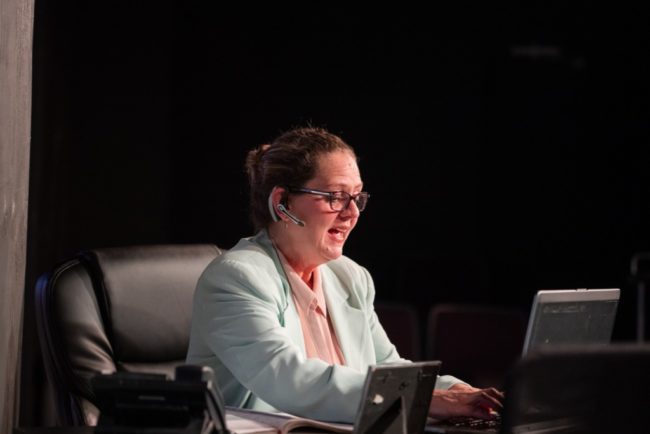Story is the way organize our lives. Narrative is how we make sense of what’s happening around us; it serves as a way to conceptualize, to frame our existence. But what about truth? What about facts? And where do they fit into our narrative? Our story? Opening their 25th Anniversary season with a play that feels topically relevant to this day and age, with a prescience that is unmistakable given that the essay, book, and play itself predate the concept of ‘fake news’, the Maryland Ensemble Theatre gets the 2022/2023 main-stage season underway with The Lifespan of a Fact by Jeremy Kareken and David Murrell and Gordon Farrell. Directed by Gené Fouché, this three-character story flashes by in just 85 minutes, begging the deep question— is there a place for truth in facts and what’s the difference?

At first the space appears raw, not quite empty, but minimalist, until the action gets underway. Scenic Designer Eric Berninghausen creates these spinning walls with projection screens built into them, cleverly disguised as portrait frames and windows. This makes for an easy transition in this tightly paced production, moving from the office in New York to the essayists home in Las Vegas a simple one. Projections Designer David DiFalco follows suit and uses these prefabricated projection panes to enhance the interior of the New York office with skyline views and an artistic ‘magazine cover’ and both screens reflect the rough desert exterior of the household in Vegas as if they were windows. The screens also double up as a broad visual representation of a computer screen for the purpose of the audience seeing the various email correspondences sent between the characters. Sound Designer Tom Majarov uses urgent music that snaps quickly between the brief blackouts between scenes, which helps keep the show’s overall pacing tight. The music itself feels like something kitschy out of a James Bond-style spy film or a 70’s sitcom, but it’s not unpleasant. All of the show’s ‘digital sound bites’, like the pinging, ringing, and zinging of various smart phones and devices, are cued with precision from the both for that authentic ‘technology is constantly with us’ vibe.
As previously mentioned, the play is tightly paced. Director Gené Fouché does a solid job of ensuring that the exchanges between characters occur naturally but with a sense of urgency— but not necessarily haste. There is a difference, much like there is a difference between truth and fact, and Fouché toes the line and finds the balance so that the play moves with purpose without feeling rushed but builds the momentum and tension that is require to deliver the exacting conclusion which it reaches in the end. And those moments of tension that Fouché develops between the characters is impressive not only because they feel realistic and authentic but because they vary. Initially when the audience meets Jim Fingal (Sean Byrne) and Emily Penrose (Laura Stark) there is a very clear and palpable tension between them. But its humorous and awkward, filled with nerves— particularly from the Jim Fingal character— and puts the audience into that “laugh because we can relate” mode. But the visceral tension, so thick you’d need a chainsaw to bust through it, that arises near the show’s conclusion is that horrifying, anxious tension that draws the audience to the edge of their seats in complete unease and discomfort because you just don’t know what’s going to happen. There’s even a moment, the penultimate breath if you will, where Fouché has the audience squirming through 48 seconds of the most brutal silence while her actors stand and count it off silently in their heads. It almost crosses the line of being too much. But Fouché manages all of this while keeping the focus on the truth of the story.

The play itself is fascinating. Playwrights Jeremy Kareken, David Murrell, and Gordon Farrell have crafted something truly brilliant with their ingenious setup of Jim Fingal and John D’Agata’s book. The narrative is the perfect dichotomy of how the generational gap experiences the world, so much beyond ‘fact vs truth’ and ‘reality vs perception.’ With the John D’Agata character showing age and stubbornness its easy to assign that ‘Boomer’ label to him and the ‘Zoomer’ label to the Jim Fingal character. The volatile battle of wills between the two can be applied to the broader strokes of life but for the intent and purpose of this play, homes in on the notion of when is it okay to play truth against fact and when does truth stop being fact and start becoming fiction? It’s brutal dissection— or perhaps cross-section— of what sort of reality we’ve come to accept when it comes to truth, facts, fictions, and how those things play out in our news, media, and lives. Kareken, Murrell, and Farrell’s work poses burning questions— like how can one say they are interested in truth but not accuracy because aren’t they one in the same? Or when and why did it become acceptable for facts to be negotiable? It’s a baffling concept; all of it is a baffling concept, and yet the way these three playwrights have written this play lets the audience perhaps see, if not understand, both sides of the argument. But why is there an argument, because when did facts stop being truth?
Performances in the three-person cast across the board are astonishing. You get this coldly aloof and completely detached in an almost comical fashion, ball-busting boss-type in Emily Penrose (Laura Stark) who doesn’t even bat an eye when zipping and quipping back and forth with Jim Fingal (Sean Byrne.) Stark does not allow the character to stagnate, however. When she arrives in the latter half of the performance at the house in Vegas, the proverbial stoic gloves of detachment come off and she’s into it full-force with gusto, fire, and even some raw, unchecked emotion. Byrne does a fantastic job of crafting this obnoxiously exacting ‘fact-checker’, the little office intern whose sole purpose in life is to get on everyone’s nerves. Byrne brings a level of animation to the character that really allows the audience to laugh both with and at him throughout the performance and yet he balances that with a realistic drive that keeps him human rather than teetering into that atmospheric caricature territory that would be easy enough to understand the way this character has been scripted.

Byrne brings comically hilarious interactions to both interactions with the Emily character and to those with the John D’Agata (Jack Evans) character. Jack Evans is a force to be reckoned with on stage in this wildly out of control role. There’s a great deal of churning fury and ire that spew right over the surface of the character and Evans brings those out without holding back. There’s a rawness to Evans’ portrayal as well, something deeply vulnerable that he buries in layers of anger, entitlement, and arrogance, so much so that you almost mistake it for losing his mind in frustration. Balancing both the dismissive comedy of the character and the serious pathos that the character is hesitant to express, Evans finds a meandering path to traverse in this role and becomes one third of a truly epic and fascinating battle— fact, truth, reality. The trio together make for a stellar performance and their unique chemistries keep audiences enthralled from start to finish.
It’s a daring way to push the envelope; opening an anniversary season with a show that isn’t from somewhere in your long-standing past. But Maryland Ensemble Theatre is taking you for a ride with their production of The Lifespan of a Fact. They’re making it your job to see the rationale in the story. Or in the truth? In the facts? Perception is a tricky thing and they’ve got that notion well in hand with this production.
Running Time: Approximately 85 minutes with no intermission
The Lifespan of a Fact plays through October 30, 2022 on the Main Stage of the Maryland Ensemble Theatre in the Historic FSK Hotel building— 31 W. Patrick street in downtown historic Frederick, MD. For tickets call the box office at (301) 694-4744 or purchase them online.
To read the interview with playwright Jeremy Kareken, click here.
